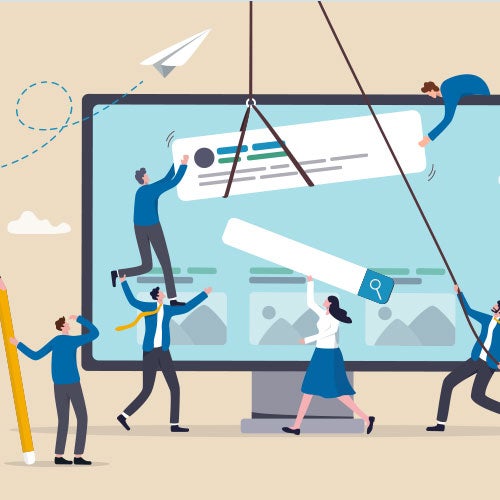Posted on 3/25/2019 in Web Development
By Matt Wiseley
In order to keep current, most companies perform major updates to their website every three to five years. In that same spirit, I’m updating this post originally published back in 2015.
A website project can span a huge range in cost, from as little as $500 to up to millions of dollars depending on many factors. Any article you find giving dollar amounts in response to this question is oversimplifying the question and making broad assumptions about the kind of website you need and that will likely result in misleading numbers.
Pricing a web redesign project requires a deep dive into many qualifying questions that help define just how big your bread box needs to be. Just what type of website do you need for your corporate entity?
This post outlines qualifiers to help you prepare for questions that will come up during a pricing exercise, and to understand up-front decisions that will help you control or at least understand the numbers as they come in.
In-House, Outsource, Boutique or Agency
Who will plan and build the new site? Answering this question is a first step towards a pricing exercise. You can estimate effort in days and hours for the tasks that make up your project? Whether you’re using sunk-cost internal resources, outsourcing parts of the project, or handing it off altogether to an agency or local boutique designer, you will apply substantially different rate multipliers and that can have a huge impact on overall cost.
Consider the benefits and drawbacks of each of these options:
- Building in-house
- Pros: You get to keep the knowledge and experience gained during the project for use in ongoing maintenance and can leverage learnings for future projects. You’re more likely to keep your site improving and updated with in-house resources.
- Cons: You’re stuck with the sunk cost of these resources and responsible for keeping them busy long-term.
- Outsource
- Pros: May be less expensive than internal resources and you pay only for what you need.
- Cons: It can be hard to validate the skills of outsourced resources and it requires significant skill and time to manage them effectively. Local and highly skilled contractors may be substantially more expensive than internal resources.
- Local Boutique
- Pros: More of a managed project experience, often local with ample references and usually less expensive than their larger counterparts.
- Cons: Boutique web shops often struggle with more technical projects and may lack the breadth of knowledge to solve a wide array of problems.
- Agency or Larger Web Shop
- Pros: Usually have strong technical staffing for larger projects, the breadth of experience to solve whatever you can throw at them and generally provide the most combined level of experience and know-how.
- Cons: For better or worse, you get what you pay for. When compared with other options (assuming things go well) this is usually the most expensive option.
Research
Knowing what should go into your site in terms of user experience, functionality, and design considerations requires research into the target audience, how they interact with the current site (if one exists), and insight into both direct and analytic feedback on what would improve their experience on the site.
This research may be done by your marketing team ahead of the project just to justify the expense. But if these questions haven’t been considered, consider who will perform this research. This type of research can easily take multiple resources months to collect.
Consider these questions when doing your research. Documenting your responses to these, even if at a high level, will help guide and frame your conversation with potential partners.
- Are you looking for help with design or do you have in-house resources for that?
- Are you rewriting or reusing content?
- Does your internal team have time to enter content on the site or do you need help?
- Identify roughly how many pages of content will your new site have?
- Which sections or pages of your site will require unique styling and layout vs. using a consistent template across pages?
- Does your site require any integrations with a CRM, marketing automation system, existing product database or ERP?
- What interactive features are you looking for? Consider search functionality, content filtering, calculators, etc.
- What are your competitors doing? Where do you need to catch up, and what opportunities exist for you to lead the pack?
Bob Ross or Andy Warhol?
Design is one of those “you get what you pay for” commodities. What’s the difference between a designer who charges $50 per hour and one that charges $500 per hour? Their portfolio and resume. If you’re looking at the Apple website and wanting that level of industry leading design vision for your site, ask yourself whether you’re willing to pay what Apple pays their art director and supporting team.
Of course, not every website needs a visionary design aesthetic and user experience. In fact, most sites benefit most from a design that is pleasing to the eye but otherwise looks and behaves as a typical visitor would expect. A more reasonably priced design resource can successfully mimic existing designs, interpreting current design trends for your audience and purpose. Base your design decision on the combination of portfolio and cost.
Design Complexity
Complexity must also be considered in design cost. If your site is fairly simple and will consist of just a few different types of pages, like a brochure website, a designer won’t need to spend lots of time working out different layouts and multi-layered navigation schemes. They may even be able to use a template. Requirements leading to design complexity include very large and nested content organization, serving a number of different target audiences or development of custom artwork and/or photography to support the content. Any of these can substantially increase the cost of your website.
Reskin or Replatform?
Established businesses can choose whether to simply reskin their existing site or start from scratch. A visual design update with some minor content reorganization on an existing site can be done quite economically. But if the current site isn’t meeting the content management or functionality requirements of your team or is on a platform that is no longer supported, you will need to include the additional cost of rebuilding from scratch.
Rebuilding increases the development effort of the project and, depending on your selected platform, may add substantial licensing fees.
If you’re talking to agencies, do not underestimate the importance of experience and proven skills on your current and selected CMS platform. Agencies who know your platform can advise whether a reskin will save money or not. On the other hand, if you are making huge sweeping changes to content and/or functionality, you may find the cost of a replatform is similar or even less expensive compared to working within your existing site. In that case, using an agency with specific experience in your platform isn’t important unless you are committed to it.
New or Changed Functionality
Functionality could include features like custom quote generators, calculators, faceted search, filtering and sorting large amounts of data, particularly for an ecommerce website. Anything that isn’t a simple page of content a marketer can enter into a CMS requires development time to plan, implement, and test. Taking the time to consider what functionality you’re looking for and defining it as a high level will aid in getting estimates for development. Prioritizing these features can help you right-size your budget once estimates are collected. If your existing site has substantial functionality that would need to be rebuilt, it can add weight to the “update” side of the update or rebuild decision.
Back Office Integrations
If your website requires integration with back-end systems like customer databases, an ERP or vendor integrations, you’ll need to consider how updating your site will impact these. Such systems are typically managed by your internal IT department, and they are the best resource to help you understand the impact of a redesign along with any new or changed functionality that might impact existing integrations. As part of a project, your IT team will work with the team building the site to establish clean boundaries between the website and the back-end systems. Having this information up front will simplify the pricing process.
These are all points to consider in pricing your corporate website project, whether you’ll build it internally or use an agency. There really is no shortcut to defining your requirements as suggested here and gathering some competing quotes from competent vendors.
Looking to update your website?
If you'd like to learn more, reach out to one of our web development experts today.
Related Articles

Demystifying SPF, DKIM and DMARC: Strengthening Email Security
With Slack and other instant messaging services handling more and more of our online communication, email can sometimes feel like a newspaper being [...]

Elevating Your Brand: The Transformative Power of Website Design
In the digital age, your website is often the first point of contact between your brand and potential customers. It's not just a platform to showcase [...]

Navigating the Digital Landscape: Website Design Trends of 2024
In the ever-evolving realm of digital innovation, website design trends serve as the compass guiding businesses and creators toward impactful online [...]

